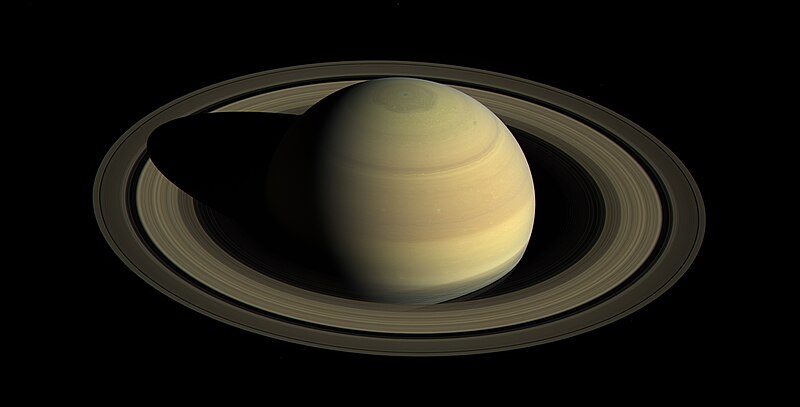File:8423 20181 1saturn2016.jpg

Original file (2,012 × 1,024 pixels, file size: 555 KB, MIME type: image/jpeg)
Captions
Captions
Summary[edit]
| Description8423 20181 1saturn2016.jpg |
Since NASA's Cassini spacecraft arrived at Saturn in mid-2004, the planet's appearance has changed greatly. The shifting angle of sunlight as the seasons march forward has illuminated the giant hexagon-shaped jet stream around the north polar region, and the subtle bluish hues seen earlier in the mission have continued to fade. Earlier views obtained in 2004 and 2009 (see PIA06077 and PIA11667) demonstrate how drastically the illumination has changed. This view shows Saturn's northern hemisphere in 2016, as that part of the planet nears its northern hemisphere summer solstice in May 2017. Saturn's year is nearly 30 Earth years long, and during its long time there, Cassini has observed winter and spring in the north, and summer and fall in the south. The spacecraft will complete its mission just after northern summer solstice, having observed long-term changes in the planet's winds, temperatures, clouds and chemistry. Cassini scanned across the planet and its rings on April 25, 2016, capturing three sets of red, green and blue images to cover this entire scene showing the planet and the main rings. The images were obtained using Cassini's wide-angle camera at a distance of approximately 1.9 million miles (3 million kilometers) from Saturn and at an elevation of about 30 degrees above the ring plane. The view looks toward the sunlit side of the rings from a sun-Saturn-spacecraft angle, or phase angle, of 55 degrees. Image scale on Saturn is about 111 miles (178 kilometers) per pixel. The exposures used to make this mosaic were obtained just prior to the beginning of a 44-hour movie sequence (see PIA21047). The Cassini Solstice Mission is a joint United States and European endeavor. The Jet Propulsion Laboratory, a division of the California Institute of Technology in Pasadena, manages the mission for NASA's Science Mission Directorate, Washington, D.C. The Cassini orbiter was designed, developed and assembled at JPL. The imaging team consists of scientists from the US, England, France, and Germany. The imaging operations center and team lead (Dr. C. Porco) are based at the Space Science Institute in Boulder, Colo. For more information about the Cassini Solstice Mission visit http://ciclops.org, http://www.nasa.gov/cassini and http://saturn.jpl.nasa.gov. עברית: כוכב הלכת החיצוני שבתאי. |
| Date | Released: September 15, 2016 (PIA 21046) |
| Source | http://www.ciclops.org/view/8423/Saturn-Approaching-Northern-Summer |
| Author | Credit: NASA/JPL-Caltech/SSI |
Licensing[edit]
| Public domainPublic domainfalsefalse |
| This file is in the public domain in the United States because it was solely created by NASA. NASA copyright policy states that "NASA material is not protected by copyright unless noted". (See Template:PD-USGov, NASA copyright policy page or JPL Image Use Policy.) |  | |
 |
Warnings:
|
Original upload log[edit]
| Date/Time | Dimensions | User | Comment |
|---|---|---|---|
| 2016-10-25 16:26:26 | 2012× 1024× | Fotaun | {{PD-NASA}} http://www.ciclops.org/view/8423/Saturn-Approaching-Northern-Summer Since NASA's Cassini spacecraft arrived at Saturn in mid-2004, the planet's appearance has changed greatly. The shifting angle of sunlight as the seasons march forward has... |
File history
Click on a date/time to view the file as it appeared at that time.
| Date/Time | Thumbnail | Dimensions | User | Comment | |
|---|---|---|---|---|---|
| current | 03:13, 14 December 2016 |  | 2,012 × 1,024 (555 KB) | FastilyClone (talk | contribs) | Transferred from en.wikipedia (MTC!) |
You cannot overwrite this file.
File usage on Commons
The following 4 pages use this file:
File usage on other wikis
The following other wikis use this file:
- Usage on ar.wikipedia.org
- Usage on ar.wikiversity.org
- Usage on ary.wikipedia.org
- Usage on arz.wikipedia.org
- Usage on ast.wikipedia.org
- Usage on ca.wikipedia.org
- Usage on ckb.wikipedia.org
- Usage on crh.wikipedia.org
- Usage on diq.wikipedia.org
- Usage on el.wikipedia.org
- Usage on en.wikipedia.org
- Pioneer 11
- Voyager 1
- Voyager 2
- Christiaan Huygens
- Saturn
- Cassini–Huygens
- Huygens (spacecraft)
- Timeline of Cassini–Huygens
- Template:Saturn spacecraft
- Exploration of Saturn
- Titan Saturn System Mission
- Kronos (spacecraft)
- Titan Mare Explorer
- Saturn's hexagon
- List of missions to the outer planets
- Titan Lake In-situ Sampling Propelled Explorer
- AVIATR
- Saturn Atmospheric Entry Probe
- Cassini retirement
- Enceladus Life Finder
- Journey to Enceladus and Titan
- Life Investigation For Enceladus
- Enceladus Explorer
View more global usage of this file.
Metadata
This file contains additional information such as Exif metadata which may have been added by the digital camera, scanner, or software program used to create or digitize it. If the file has been modified from its original state, some details such as the timestamp may not fully reflect those of the original file. The timestamp is only as accurate as the clock in the camera, and it may be completely wrong.
| Image title | IDL TIFF file |
|---|---|
| Width | 2,012 px |
| Height | 1,024 px |
| Bits per component |
|
| Compression scheme | Uncompressed |
| Pixel composition | RGB |
| Orientation | Normal |
| Number of components | 3 |
| Horizontal resolution | 100 dpi |
| Vertical resolution | 100 dpi |
| Data arrangement | chunky format |
| Software used | Adobe Photoshop CS6 (Macintosh) |
| File change date and time | 17:06, 14 September 2016 |
| Color space | Uncalibrated |
| Date and time of digitizing | 09:42, 14 September 2016 |
| Date metadata was last modified | 10:06, 14 September 2016 |
| Unique ID of original document | xmp.did:018011740720681183D1E578F599C4C0 |